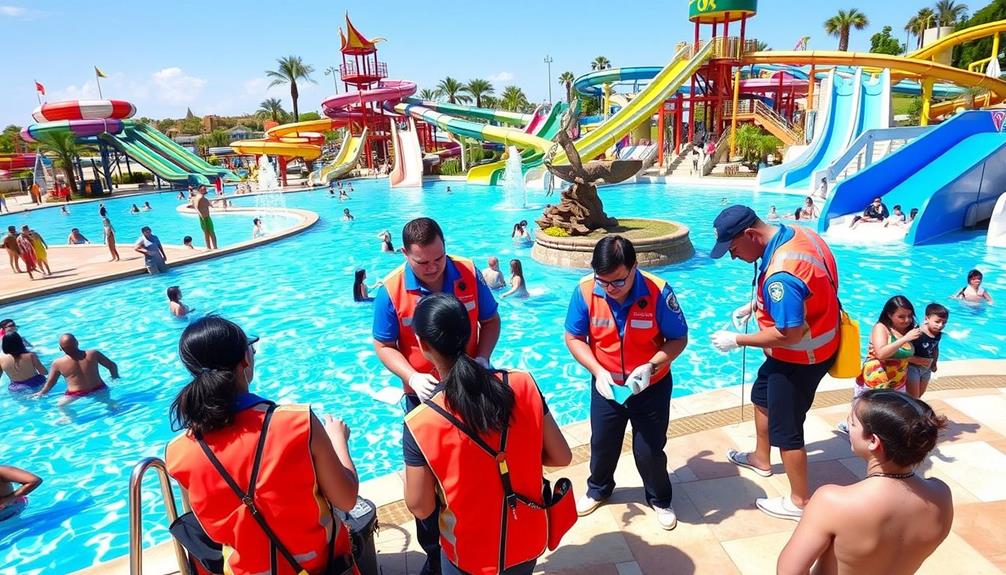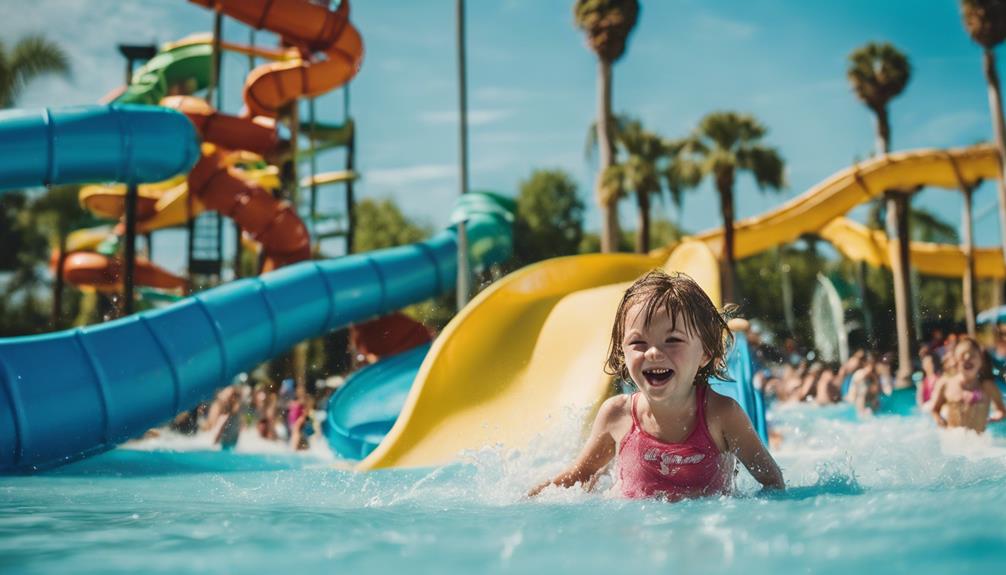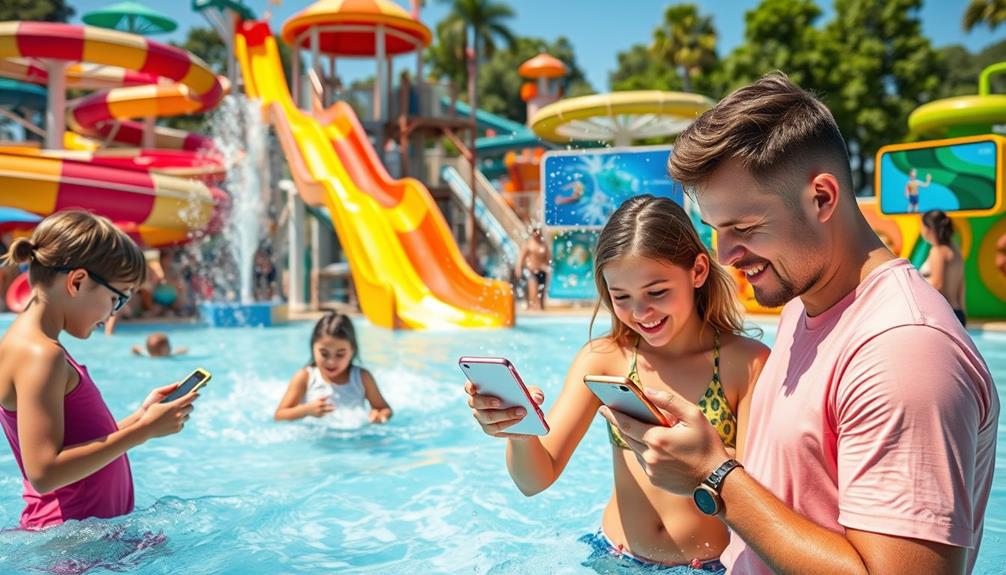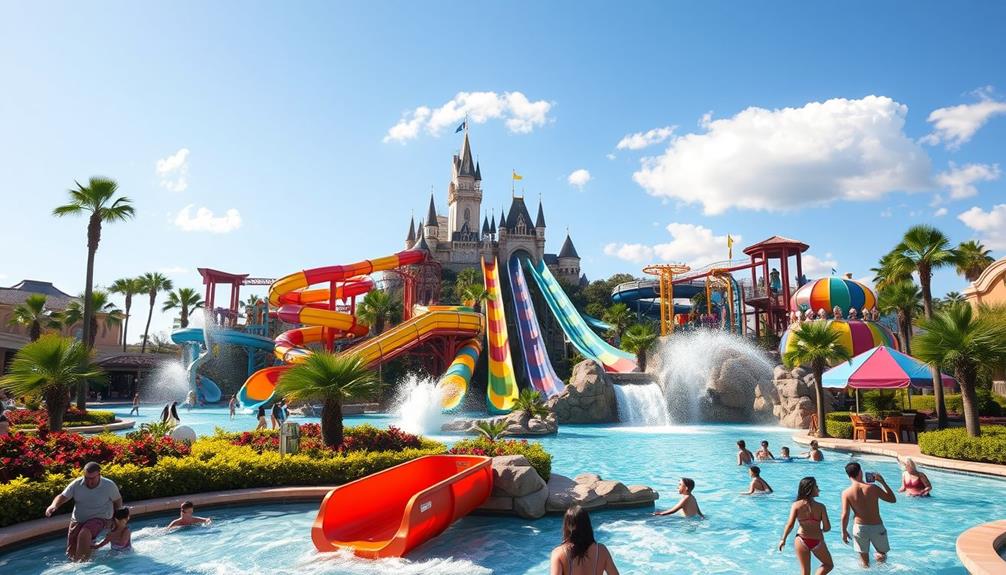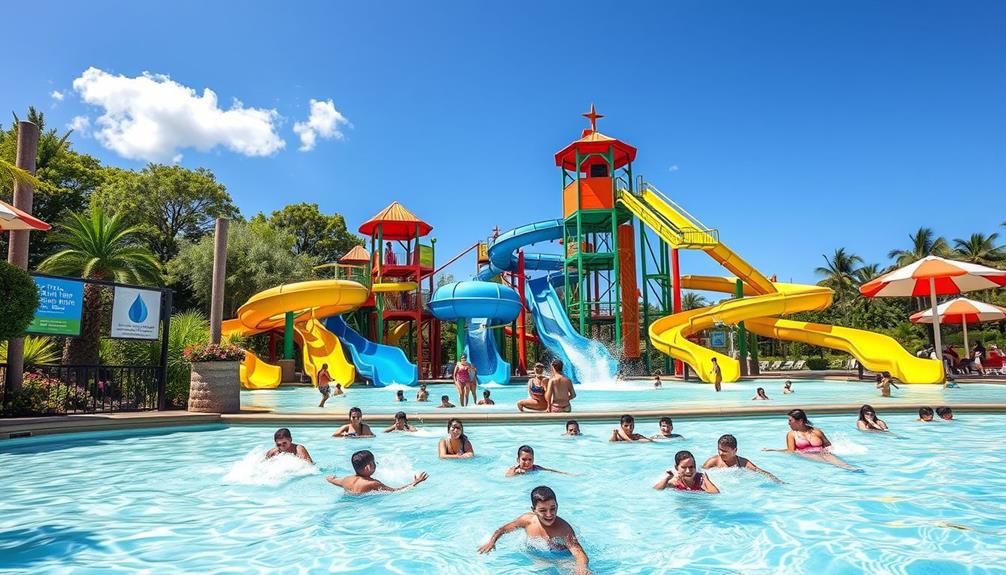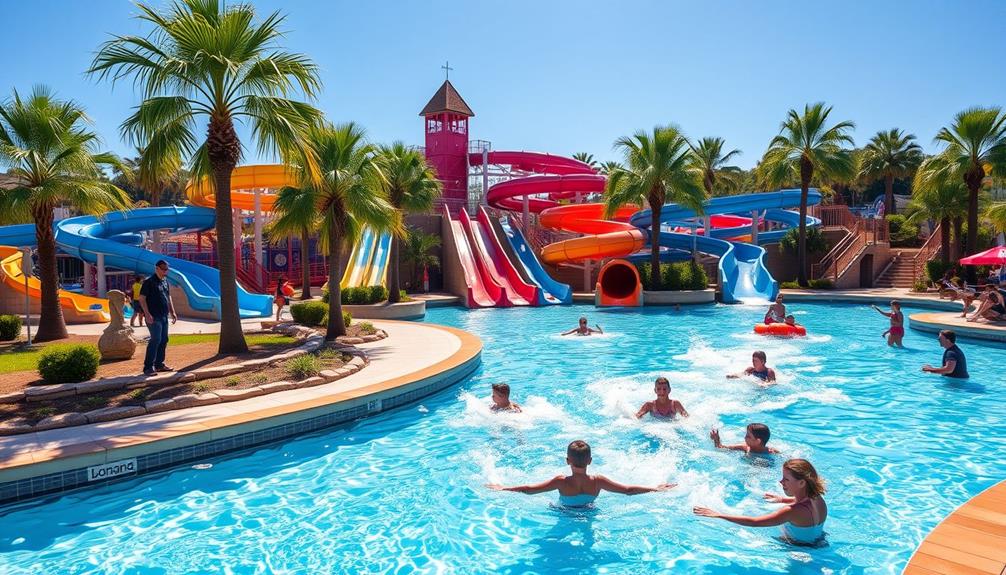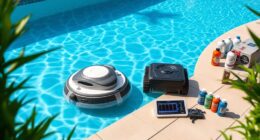Water parks prioritize cleanliness and safety through advanced filtration systems and rigorous safety protocols. You'll find that they maintain pH levels around 7.4 and keep free chlorine between 1.0-3.0 PPM to eliminate harmful bacteria. Real-time monitoring guarantees instant adjustments to water quality, while UV treatments enhance sanitation. Staff undergo thorough training in emergency response and maintenance. Regular inspections help catch potential issues before they arise. Utilization of technology, like robotic vacuums, simplifies debris management. All these efforts guarantee a safe experience for you and your family. If you're curious about how technology plays a role, you'll want to keep exploring this topic.
Key Takeaways
- Advanced filtration systems utilize eco-friendly materials and modular designs for efficient maintenance and high water quality in water parks.
- Continuous monitoring of pH and chlorine levels ensures immediate adjustments and effective sanitation through combined chlorination and UV treatment methods.
- Regular inspections and meticulous maintenance protocols are crucial for the safety of rides and attractions, preventing structural flaws and ensuring visitor safety.
- Staff training includes emergency protocols, first aid, and water rescue techniques to enhance preparedness and response in case of incidents.
- Hygiene education for guests, along with clear signage, promotes safe practices and reduces contamination risks within the park environment.
Water Park Filtration Systems
When you visit a water park, the cleanliness and safety of the water play an essential role in your experience. Water parks use advanced filtration systems to guarantee high water quality, creating a clean environment for all guests. These systems incorporate premium pumps and corrosion-resistant materials, designed for longevity and effectiveness.
Additionally, many parks are adopting eco-friendly materials in their construction and renovation processes to minimize environmental impact. Modular filtration systems are particularly popular because they adapt easily to various water park designs and needs, making maintenance a breeze. To capture larger particulates, some parks even use effective filtration methods like sphagnum moss, which contributes to the overall cleanliness of the water.
Continuous monitoring is key, and sensors track important pH levels—ideally around 7.4—and free chlorine concentrations between 1.0-3.0 PPM. This rigorous cleaning guarantees that safety standards are met, providing you with peace of mind while enjoying your day.
Additionally, the combination of chlorine treatment and UV water treatment systems enhances the disinfection process, further guaranteeing a safe environment for visitors. By prioritizing environmental sustainability, water parks can maintain their high standards of cleanliness and safety without compromising on fun.
Water Treatment Methods
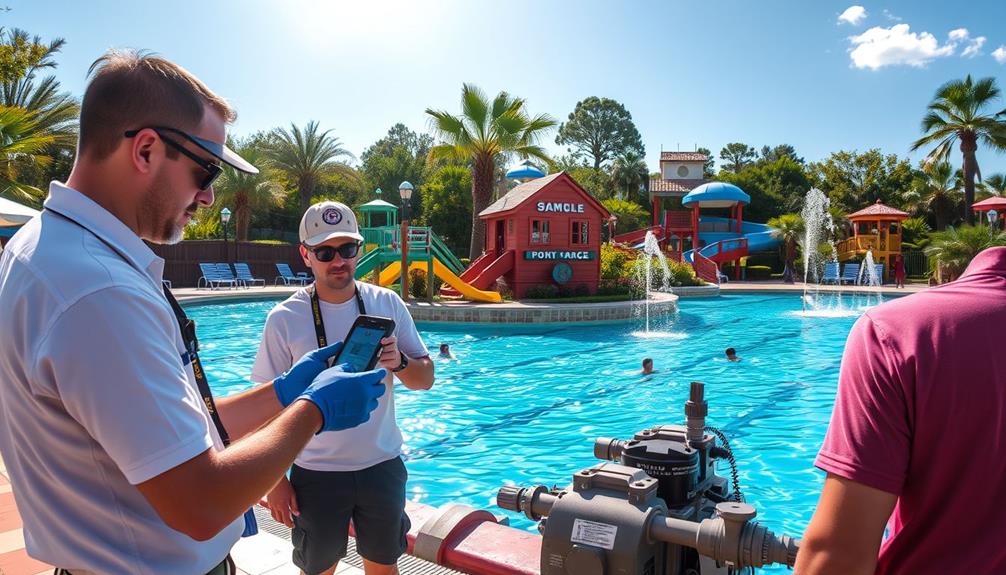
Ensuring clean and safe water in water parks relies heavily on effective water treatment methods. Chlorination is one of the key methods, maintaining free chlorine levels between 1.0-3.0 PPM. This helps eliminate harmful bacteria like E. coli and salmonella, ensuring guests can enjoy their time without worry.
To enhance water cleanliness, many parks also utilize advanced technologies like top robotic vacuums for pools that automate debris collection. Complementing chlorination, UV water treatment systems emit specific wavelengths that disrupt microorganisms' DNA, considerably reducing chloro-organics and chloramines.
To maintain water quality, continuous monitoring is essential. You'll find that this includes keeping an ideal pH around 7.4, which helps prevent harmful contaminants. Free chlorine sensors play a vital role by providing real-time measurements, allowing staff to make immediate adjustments to disinfectant levels and protect against bacterial survival.
Additionally, water parks utilize advanced filtration methods, such as sphagnum moss, to capture larger particulates. This further contributes to the overall cleanliness and quality of the water.
Monitoring Water Quality
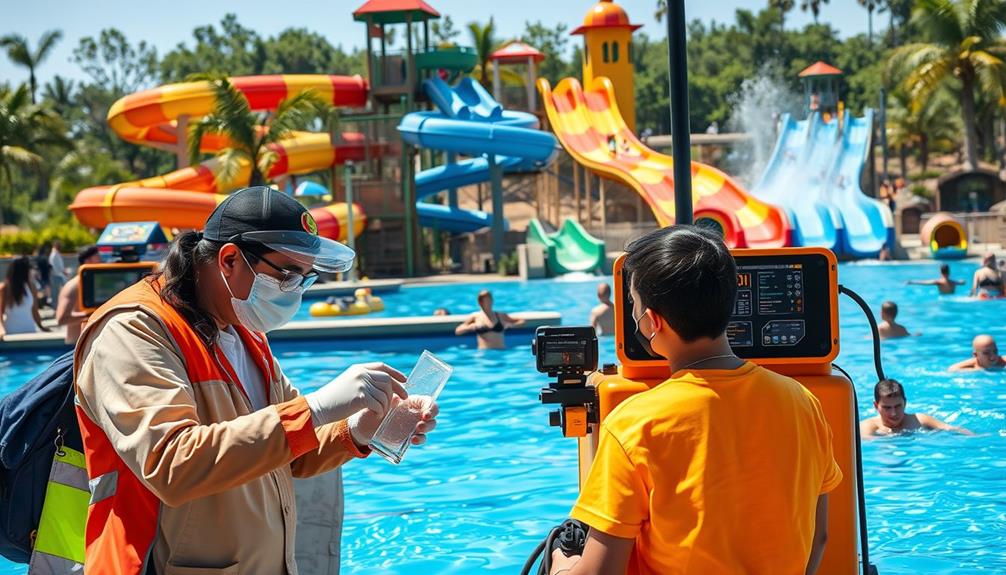
Monitoring water quality is essential for maintaining a safe and enjoyable experience at water parks. You rely on advanced water quality sensors that continuously monitor key parameters like pH levels, ideally around 7.4, and free chlorine concentrations maintained between 1.0-3.0 PPM. These measurements are critical for effectively eliminating harmful bacteria, such as E. coli and Salmonella.
Additionally, maintaining optimal air quality within the park is important, as poor air can affect the overall guest experience, similar to how ozone air purifiers help eliminate allergens and odors indoors.
By utilizing real-time monitoring, you can make immediate adjustments to chemical levels, guaranteeing the cleanliness and safety of the water. The park employs a combination of chlorination and UV water treatment systems, where UV light disrupts microorganism DNA, enhancing chlorine's disinfection properties.
Regular maintenance of filtration systems is fundamental as well. Effective filters, such as sphagnum moss, capture larger particulates, contributing considerably to overall water cleanliness.
With remote monitoring capabilities, water quality sensors allow for quick responses to any deviations from safety standards. This guarantees that any issues are addressed promptly, protecting guest health and enhancing their experience.
In short, diligent monitoring of water quality not only maintains cleanliness but also plays a crucial role in ensuring the safety of all visitors at the water park.
Ensuring Visitor Safety

Maintaining high-quality water quality is just one part of the larger picture when it comes to visitor safety at water parks. To guarantee that guests have a safe experience, water parks implement various measures that go beyond just keeping the water clean.
Regular inspections and maintenance of rides are as essential as monitoring dog health and care to prevent hazards and guarantee safety.
Consider these important practices:
- Meticulous maintenance: Regular inspections and maintenance protocols for rides and attractions are essential. Non-destructive testing methods help identify any structural flaws that could pose risks.
- Staff training: All staff undergo extensive training in emergency protocols, first aid, CPR, and water rescue techniques. This preparedness is critical for handling potential hazards like drowning and injuries.
- Hygiene education: Clear signage and continuous education on hygiene practices, such as showering before entering pools, promote a safe environment. This guarantees that the water remains clean and reduces the risk of contamination.
Role of Technology in Maintenance
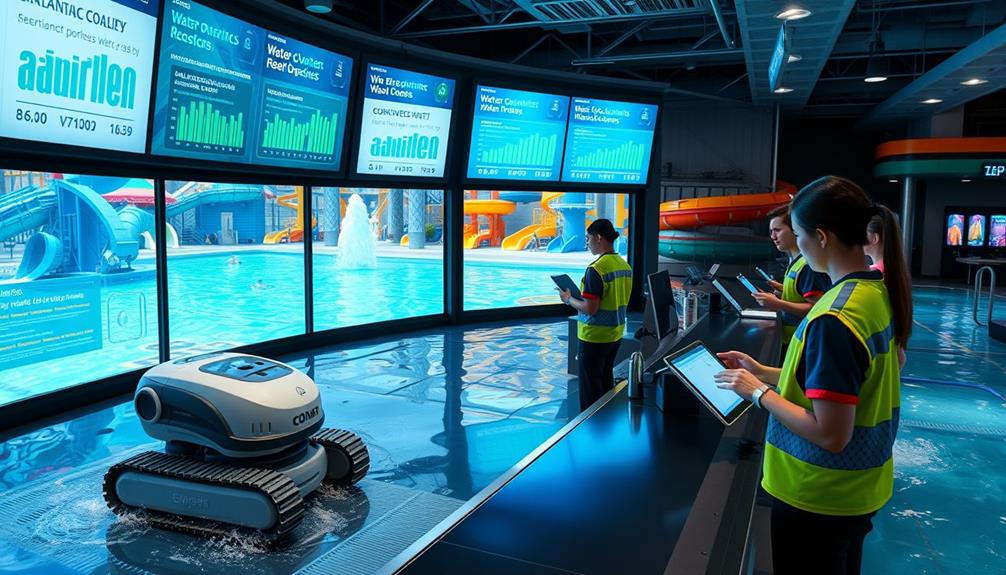
As water parks endeavor to provide a safe and enjoyable experience, technology plays an essential role in their maintenance efforts. Advanced filtration systems made from corrosion-resistant materials guarantee that water quality remains high. These systems utilize premium pumps and sensors that continuously monitor pH levels, keeping them around 7.4, and maintain free chlorine concentrations between 1.0-3.0 PPM for ideal safety.
Additionally, just as vacuums with effective pet hair removal simplify maintenance in pet-friendly homes, these systems streamline water quality management, saving time and effort for park staff.
Furthermore, UV water treatment systems enhance sanitation by emitting specific wavelengths that disrupt microorganism DNA, all while complementing traditional chlorination methods. Ozone sanitation technology, 200 times stronger than chlorine, effectively eliminates bacteria, viruses, and other harmful contaminants, reducing reliance on conventional chemicals.
Remote monitoring capabilities integrated into water quality management systems allow staff to quickly respond to any fluctuations in water conditions. This real-time data guarantees that safety measures are always in place, making your visit worry-free.
Frequently Asked Questions
How Do You Keep Things Safe at a Waterpark?
You keep things safe at a waterpark by conducting regular safety inspections, ensuring staff gets ongoing training, monitoring water quality consistently, and practicing emergency drills. These steps help maintain a fun, safe environment for everyone.
How Can We Maintain the Cleanliness of the Park?
To maintain the park's cleanliness, you can follow dedicated cleaning schedules, utilize eco-friendly products, and encourage responsible waste disposal. Regularly check high-traffic areas, and remember to report any issues to staff for prompt action.
What Is One Safety Precaution You Should Take at a Water Park?
When you plunge into fun, remember: safety first! Always follow posted rules and guidelines. They're your lifeguard's lifeline, ensuring you stay safe while enjoying thrilling rides and splashing adventures with friends and family.
What Should You Keep in Mind While Going to the Water Park?
When you head to the water park, remember to shower before entering, check pH and chlorine levels, stay in designated areas, and follow the rules. These steps help guarantee your safety and enjoyment.
Conclusion
In the end, keeping water parks clean and safe is no small feat. With advanced filtration systems, effective treatment methods, and constant monitoring, you can plunge in knowing you're in good hands. Safety measures are always in place, so you can focus on fun instead of worry. Isn't it reassuring to know that while you splash and play, technology works tirelessly behind the scenes, ensuring every drop of water is as safe as it is invigorating?

